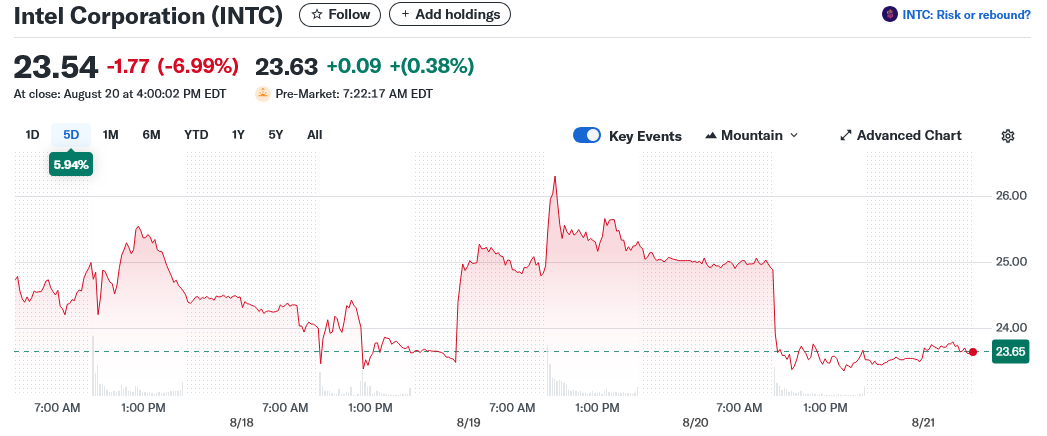TLDR
- Intel stock rallied 28% this month on reports of potential 10% US government stake and $2 billion SoftBank investment
- Stock now trades at 53 times forward earnings, highest valuation since dot-com era in 2002
- Trump administration discussing converting existing CHIPS Act grants into non-voting equity position
- CEO Lip-Bu Tan faces scrutiny over Chinese firm connections and calls for resignation
- Company projects return to $1 billion profit after losing $1.3 billion in previous four quarters
Intel shares have been on a wild ride this month, but not the kind investors typically celebrate. The chipmaker’s stock jumped 28% in August, adding roughly $24 billion in market value, yet this rally comes with a hefty price tag.
The surge began after reports emerged that the US government was considering taking a 10% equity stake in the company. Commerce Secretary Howard Lutnick confirmed Tuesday that the Trump administration is exploring ways to convert existing CHIPS Act grants into non-voting equity positions.
This government interest, combined with news of a potential $2 billion investment from Japan’s SoftBank Group, has sent Intel’s valuation into the stratosphere. The stock now trades at 53 times projected earnings over the next 12 months.

That multiple hasn’t been seen since early 2002, during the aftermath of the dot-com bubble. Back then, tech stocks carried sky-high valuations that proved unsustainable for many companies.
“The stock looks incredibly expensive here,” said Wayne Kaufman, chief market analyst at Phoenix Financial Services. “That kind of multiple is a bet that the government will push Intel so hard on customers that it becomes a winner.”
Government Involvement Creates New Dynamics
The potential government stake represents a major shift for Intel, which has operated as a purely private enterprise since its founding. The discussions stem from the CHIPS and Science Act, which already allocated grants to Intel for domestic semiconductor manufacturing.
Converting these grants to equity would give the US government a direct ownership position in one of America’s largest chipmakers. This move reflects broader national security concerns about semiconductor supply chains and competition with China.
However, the arrangement raises questions about Intel’s future independence. Paul Nolte from Murphy & Sylvest Wealth Management warned that government involvement could create long-term complications.
“This strikes me as an easy road to get onto, but a hard one to get out of,” Nolte said. “At the end of the day, this raises so many more questions than it answers.”
The government stake discussions coincide with increased scrutiny of CEO Lip-Bu Tan. President Trump previously called for Tan’s resignation, citing conflicts of interest related to his connections with Chinese firms.
Financial Reality Behind the Rally
Intel’s extreme valuation reflects the company’s dramatic profit decline rather than explosive growth prospects. The chipmaker is projected to generate just over $1 billion in adjusted profit over the next four quarters.
This represents a stark contrast to Intel’s recent performance. The company lost approximately $1.3 billion in the previous four quarters, a sharp reversal from its historical profitability.
Between 2018 and 2021, Intel averaged more than $20 billion in annual profits. The current projections, while positive, represent a fraction of the company’s former earning power.
Intel’s balance sheet shows $44 billion in long-term debt and a current ratio of 1.2. The company posted gross profit of $3.54 billion in the most recent quarter but recorded a net loss of $2.91 billion.
Wall Street analysts remain cautious about Intel’s prospects. Fewer than 8% of tracked analysts recommend buying the stock, while nearly 80% maintain neutral ratings.
At Tuesday’s close of $25.31, Intel trades above the average analyst price target of approximately $22. This gives the stock the weakest return potential among Nasdaq 100 components.
Nancy Tengler, CEO of Laffer Tengler Investments, expressed skepticism about Intel’s valuation given its technological challenges. “We have no idea what Intel can deliver in earnings growth since it is so behind on tech,” she said.
The company’s financial metrics paint a challenging picture. Intel posted an EBIT margin of -20.4% and a profit margin of -39.67% in recent quarters.
Despite these headwinds, Intel continues investing heavily in research and development, spending $3.68 billion in the latest reporting period. The company maintains gross margins near 40%, suggesting some underlying operational strength.
CEO Tan has focused primarily on cost-cutting measures since taking over from Pat Gelsinger. While these efforts have improved Intel’s path back to profitability, they’ve raised concerns about the company’s ability to compete technologically.
Intel shares fell 1.4% in premarket trading Wednesday, suggesting some cooling of the recent rally. The government stake discussions remain ongoing and could still change, according to officials familiar with the matter.


